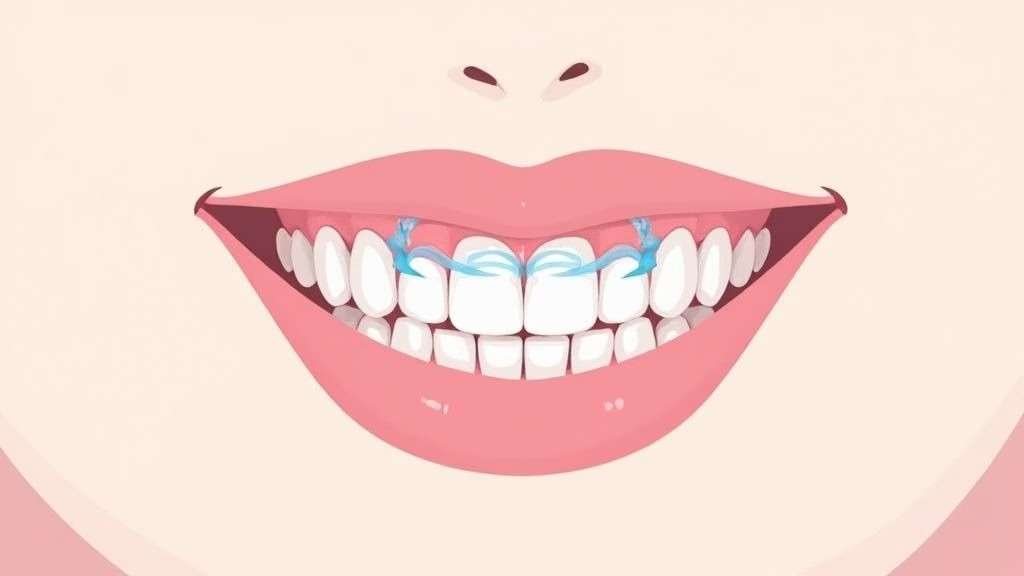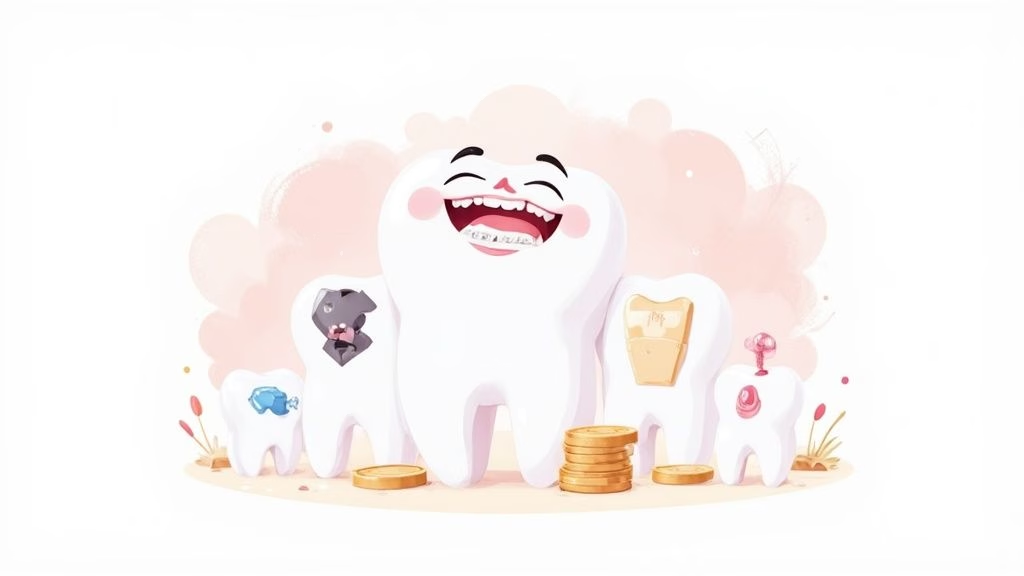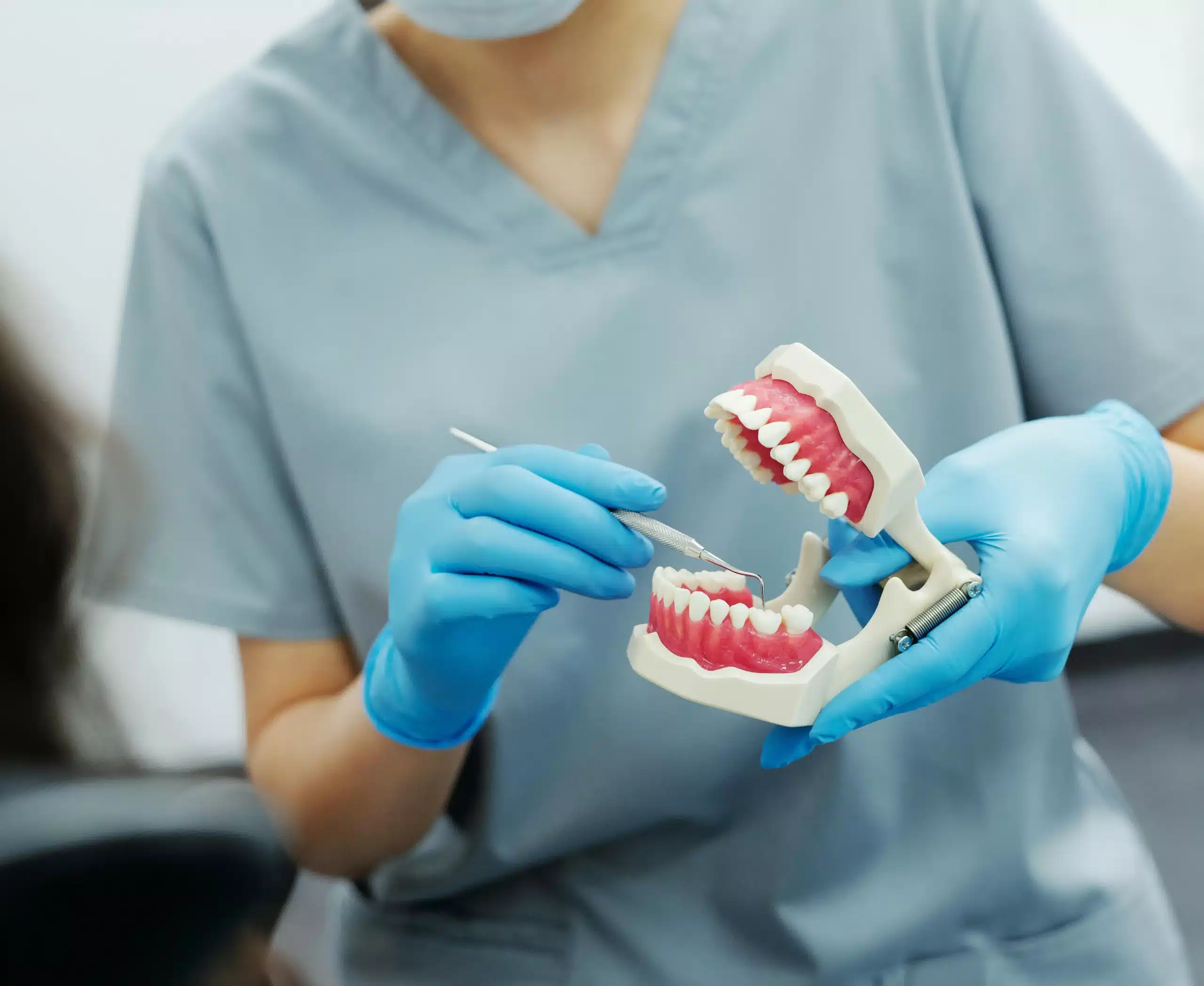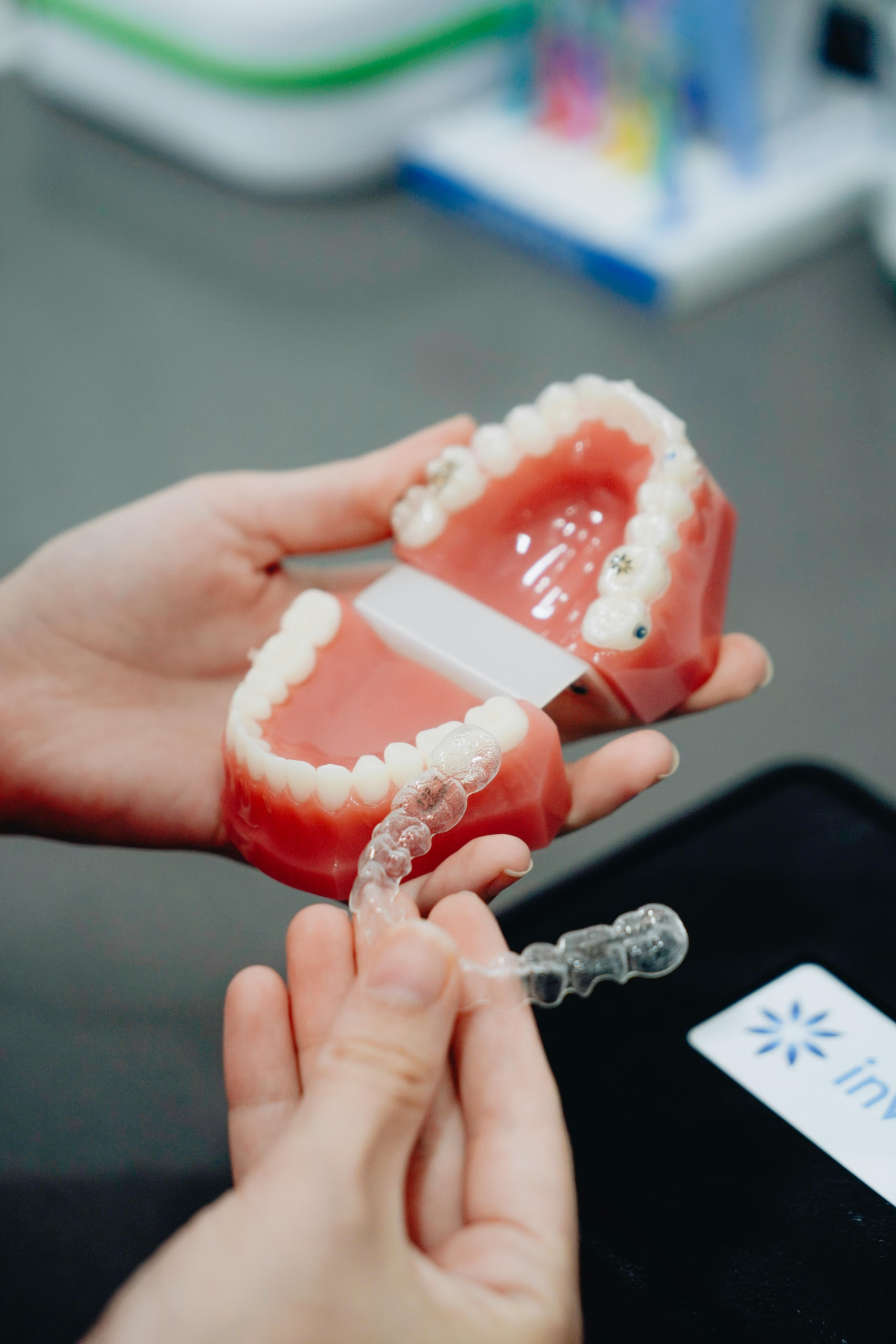Effective Cracked Tooth Pain Relief: Expert Guide To Immediate Comfort

Understanding Your Cracked Tooth Pain: Beyond The Basics

A cracked tooth can cause various types of pain, from mild discomfort to severe throbbing. Understanding how different cracks affect your teeth helps you find the right treatment. The key is recognizing specific symptoms and knowing what makes the pain better or worse.
Types of Cracks and Their Impact
Different cracks affect teeth in distinct ways. Surface-level cracks may only impact the outer enamel, while deeper cracks can reach the tooth’s nerve. Craze lines are small surface cracks that usually don’t cause pain. A split tooth with a crack extending below the gum line often causes significant pain and needs major treatment. Fractured cusps and vertical root fractures each create their own unique pain patterns.
Identifying Your Specific Symptoms
Pay attention to exactly how your tooth pain feels – this helps your dentist determine the best treatment. You might feel sharp pain when biting down on food, especially hard items. Many people also notice their teeth become sensitive to cold drinks and foods. Some experience a dull ache that lingers after releasing bite pressure. Each type of pain offers clues about the crack’s location and severity.
Research shows that cracked tooth syndrome (CTS) causes specific pain patterns. Common symptoms include sharp pain when biting and sensitivity to cold. The harder you bite down, the worse the pain typically gets. Many patients also report pain when eating stringy foods or clenching their teeth. Sweet foods and hot temperatures can trigger discomfort too.
Factors That Worsen Cracked Tooth Pain
Several everyday activities can make cracked tooth pain worse. Biting hard foods puts direct pressure on the crack. Teeth grinding, whether during sleep or from stress, adds harmful force. Even normal temperature changes from hot coffee or cold drinks can trigger pain. Knowing these triggers helps you avoid making the pain worse while waiting for dental treatment.
Immediate Relief Strategies That Actually Work

When you’re dealing with a cracked tooth, the pain can be intense and disruptive. The good news is that there are several effective ways to manage the discomfort until you can see a dentist. These proven strategies can help you regain comfort and function in your daily activities.
Over-the-Counter Pain Management
Pain relievers from your local pharmacy can provide quick relief. Ibuprofen helps reduce inflammation and ease pain, while acetaminophen targets general discomfort. Be sure to read and follow the dosage instructions carefully. If you take other medications, check with your pharmacist about potential interactions.
Natural Remedies for Soothing Relief
Simple home remedies can work alongside medication to boost comfort. A warm salt water rinse helps clean the area and reduce swelling – just mix a half teaspoon of salt in warm water and swish gently for 30 seconds. For extra relief, apply a cold compress to your cheek near the painful tooth. The cold helps numb the area and decrease inflammation.
Practical Tips and Dos & Don’ts
Small changes in your daily habits can make a big difference. Avoid chewing on the side with the cracked tooth to prevent further damage. Stay away from very hot or cold foods and drinks since temperature changes often trigger pain. If you grind your teeth at night, using a mouthguard can protect the damaged tooth and reduce discomfort.
Creating a Personalized Relief Plan
Since pain affects everyone differently, the best approach combines multiple relief methods. You might find that alternating between pain medication and salt water rinses works well, or that using a cold compress while avoiding hard foods brings the most comfort. Test different combinations to find what helps you most. For expert guidance on managing your specific situation, contact Toothfairy to connect with dental professionals who can create a custom pain management plan while you await treatment.
Professional Treatment Options: Making Informed Decisions

Getting proper treatment for a cracked tooth starts with understanding your options. Dental professionals evaluate each case carefully, considering factors like the type and severity of the crack before recommending specific treatments.
Common Dental Procedures for Different Types of Cracks
Dentists offer several proven treatments to address tooth cracks and relieve pain:
- Bonding and Contouring: Best for minor surface cracks and craze lines
- Dental Crowns: Provides full coverage protection for larger fractures
- Root Canal Treatment: Essential when cracks reach the tooth pulp
- Tooth Extraction: Required for severe vertical root fractures beyond repair
Each treatment aims to stop pain, restore function, and improve appearance. For example, a crown not only protects the damaged tooth but also helps maintain its natural shape and strength.
Treatment Success and Long-Term Results
Research shows excellent outcomes for most cracked tooth treatments when done promptly. Root canal procedures have success rates of 86-98% in treating cracked teeth. Modern dental crowns, especially those made with porcelain fused to metal, typically last 15+ years with good oral care.
Treatment Patterns Across Regions
Treatment choices often vary by location. Recent UK dental health surveys show that 76-83% of adults have dental fillings, while crown usage ranges from 30-40% depending on the area. These numbers reflect how common restorative dental work has become for addressing tooth damage. Learn more about UK dental health statistics.
Getting the Most From Your Dental Consultation
Make your dental visits more productive by asking the right questions. Get clear information about why certain treatments are recommended, what materials will be used, and what to expect during recovery. Taking an active role helps ensure you get the most appropriate treatment.
Good treatment decisions come from understanding your options, knowing what to expect, and working with a skilled dental professional. For additional guidance and virtual consultations, consider using platforms like Toothfairy.
Navigating Emergency Dental Care Successfully

When you face a dental emergency like a cracked tooth with intense pain, having a clear action plan is essential. The key is knowing what qualifies as an emergency, finding quick treatment, and working effectively with dental professionals.
Identifying a True Dental Emergency
Not every dental problem needs immediate care. However, certain situations require urgent attention, such as:
- A cracked tooth with severe pain
- Active bleeding
- Noticeable swelling
- A loose or knocked-out tooth
Being able to spot these critical signs helps you get proper care when needed most.
Accessing Prompt Treatment and Communicating Effectively
During an emergency, start by calling your regular dentist – many provide emergency services or can refer you to an emergency clinic. Services like Toothfairy offer virtual consultations and emergency care through secure video calls. When you contact a dental office, provide clear details about your symptoms so they can properly assess your situation.
Preparing for Your Emergency Appointment
Before your visit, gather these important items:
- Dental insurance card
- List of current medications
- Information about any allergies
- Timeline of when symptoms started
Recent data shows the impact of limited dental access – between March 2020 and March 2021 in England, 35% of adults needed dental treatment, with 31% reporting tooth or mouth pain. Learn more in this detailed report on dental care access.
Understanding Insurance and Payment Options
Don’t let financial concerns stop you from getting emergency care. Contact your insurance provider to check your coverage for emergency treatment. Many dental offices provide payment plans or accept major credit cards to help manage unexpected costs.
Managing Anxiety During a Dental Crisis
It’s normal to feel anxious during a dental emergency. Try these tips to stay calm:
- Practice deep breathing exercises
- Use mindfulness techniques
- Tell the dental staff about your concerns
- Ask questions about the treatment process
The dental team is there to help and can provide reassurance throughout your visit.
Building Your Long-Term Protection Strategy
A healthy, crack-free smile requires more than addressing immediate dental issues. It needs a well-planned, ongoing approach to protect your teeth over time. By following key habits and making smart adjustments to your routine, you can prevent future dental problems and avoid needing cracked tooth pain relief.
Lifestyle Modifications for Stronger Teeth
Small changes in your daily habits can make a big difference in protecting your teeth. Avoiding hard objects and managing teeth grinding through stress reduction helps prevent new cracks and stops existing ones from getting worse. Many patients who maintain healthy teeth credit these preventive habits for their success.
- Quit Smoking: Tobacco use weakens gums and tooth support through increased disease risk
- Stress Management: Use calming techniques like deep breathing or yoga to reduce grinding
Importance of Dietary Choices
What you eat directly impacts your dental health. Foods high in calcium and phosphates build stronger enamel, while too much sugar and acid can wear it down and make teeth more likely to crack.
- Increase Intake of Dairy Products: Choose milk, cheese, and yogurt for calcium
- Limit Sugary Snacks and Drinks: These foods damage enamel and raise crack risk
Advanced Oral Hygiene Techniques
Good oral care means more than basic brushing and flossing. People with healthy teeth long-term follow these key practices:
- Use a Soft-Bristled Brush: Cleans well without harming gums or enamel
- Consider an Electric Toothbrush: Offers better cleaning than manual brushing
- Regular Flossing and Use of Mouthwash: Removes hard-to-reach debris and bacteria
Professional Advice and Products
Regular dental visits help catch problems early. Dentists often suggest specific items to support dental health:
- Fluoride Toothpaste: Strengthens enamel against decay and cracks
- Custom Mouthguards: Important for those who grind their teeth
Early Warning Signs and Quick Action
Knowing your oral health lets you spot and address problems quickly. If you notice changes like increased sensitivity or cracks, see a dental professional right away to prevent more damage. For fast access to expert care and advice, services like the Toothfairy app can connect you with dental professionals.
Using these prevention methods makes a real difference in keeping your teeth healthy and reduces the need for emergency dental work. Taking these steps helps protect your natural smile for years to come.
Critical Signs That Demand Professional Attention
Knowing when a cracked tooth requires immediate professional care can help prevent complications and ensure effective treatment. While some cracked tooth pain can be managed at home, specific symptoms indicate you need urgent dental attention. Understanding these signs helps you make smart decisions about your dental health.
Understanding Mild vs. Serious Symptoms
Minor temperature sensitivity or occasional pain when biting can often be handled with home remedies. However, watch for intense, continuous pain that occurs without biting – this signals possible damage to the tooth’s nerve center. Be particularly concerned if pain comes with swelling, fever, or a foul taste, as these suggest infection requiring immediate professional help.
Signs of Developing Complications
An untreated cracked tooth can lead to serious issues. A crack extending below the gums creates an opening for bacteria to enter. If the crack reaches the tooth’s inner core, you may need a root canal procedure to preserve the tooth. Without proper care, you risk losing the tooth completely. Early professional treatment is essential to prevent these outcomes.
Effects of Waiting Too Long
Putting off treatment for a cracked tooth impacts your overall dental wellness. Small cracks tend to grow larger over time, often requiring more extensive and expensive procedures later. Infections that start in the tooth can spread to surrounding tissues and bone. In some cases, dental infections can affect your general health. Getting prompt professional care protects both your dental and overall health.
When to See a Dentist Immediately
These symptoms mean you should contact a dental professional right away:
- Strong, ongoing pain: Pain that doesn’t improve with over-the-counter medications
- Gum swelling: Noticeable swelling around the affected tooth
- Fever: Higher body temperature suggesting infection
- Temperature reactions: Lasting pain from hot or cold exposure
- Eating problems: Pain that makes normal eating difficult
- Visible damage: A crack you can see on the tooth
This guide helps you assess cracked tooth pain and decide when to seek professional help. Quick action often prevents bigger problems and leads to better outcomes. For urgent dental needs, connect with qualified dentists through Toothfairy app for fast expert advice and care.
Last updated on February 21, 2025

Toothfairy Care Team
Toothfairy, is the world's smartest dental app, that connects patients to a dentist for a range of issues, from emergencies, cosmetics, prescriptions to virtual exams.
Toothfairy Care Team
Toothfairy, is the world's smartest dental app, that connects patients to a dentist for a range of issues, from emergencies, cosmetics, prescriptions to virtual exams.





